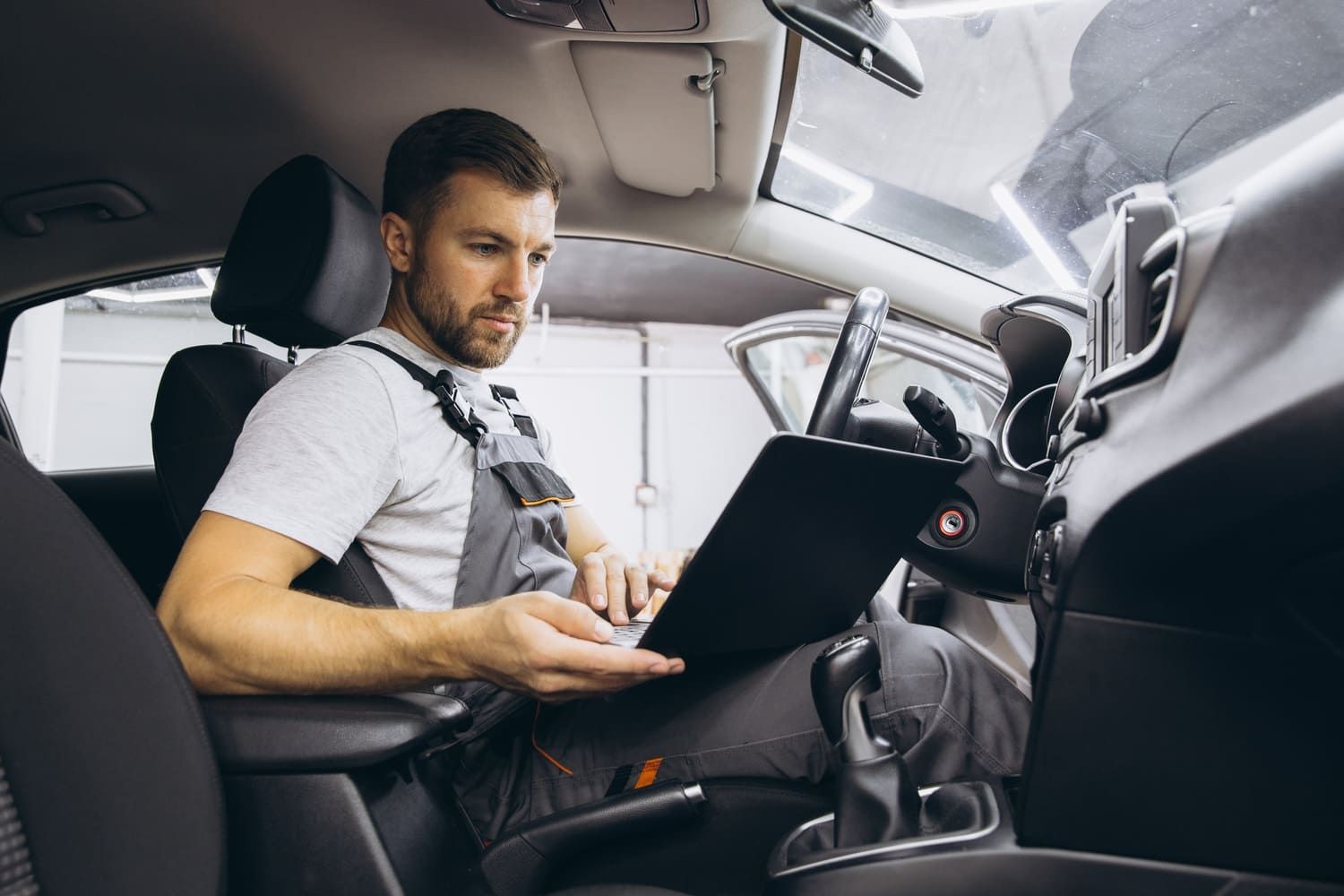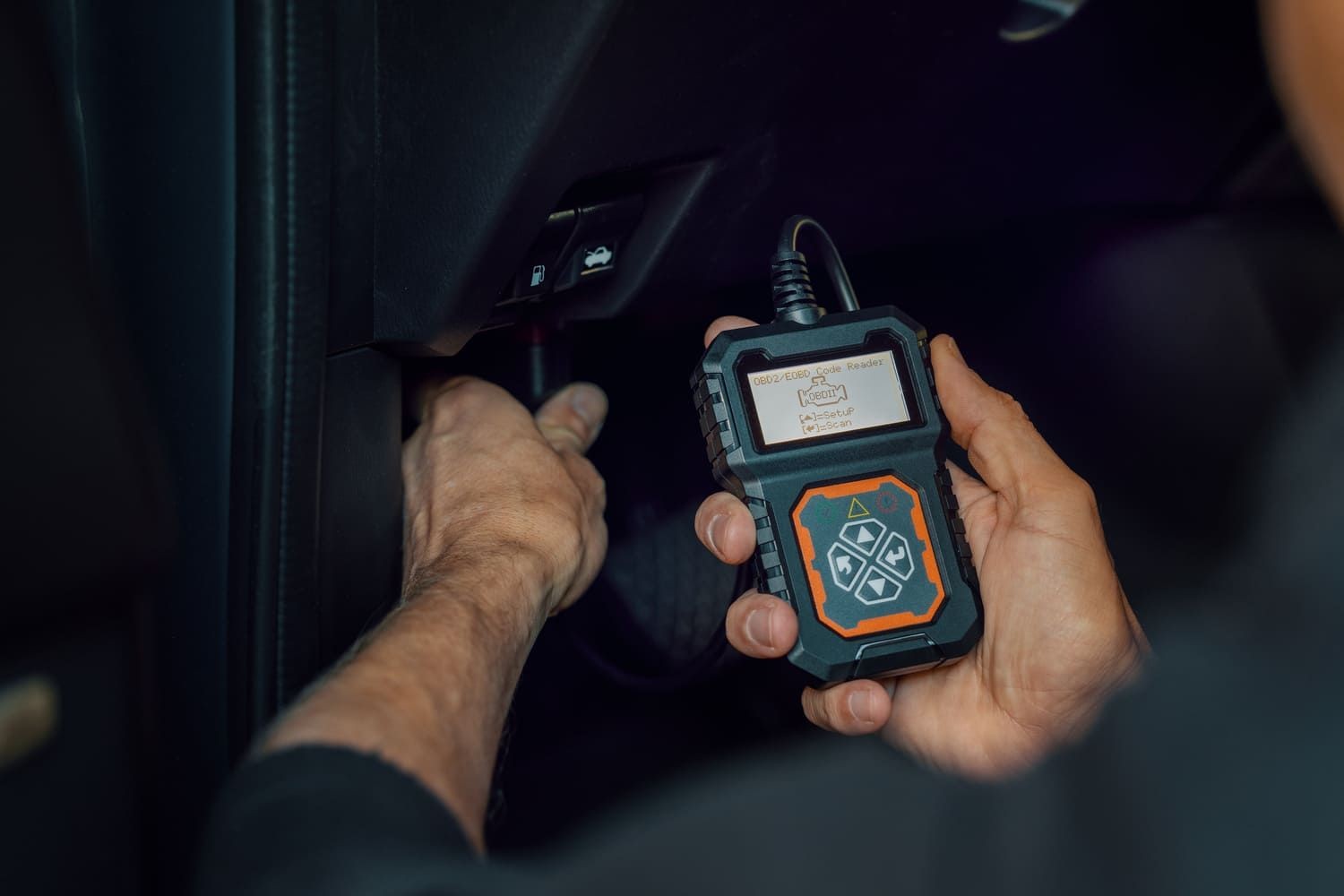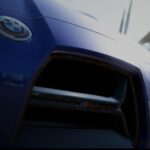The Obd Scanner Port, also known as the on-board diagnostics port, is your car’s gateway to revealing its inner workings, allowing you to access critical data and diagnose potential issues – CAR-TOOL.EDU.VN offers comprehensive information on these ports. By understanding this essential component, you can efficiently monitor your vehicle’s health, interpret diagnostic trouble codes, and potentially save money on repairs, making it an invaluable tool for both experienced mechanics and car enthusiasts alike. Unlock the secrets of your vehicle with the right diagnostic tools, explore car diagnostic systems, and perform vehicle computer diagnostics with the knowledge you gain.
Contents
- 1. What is an OBD Port?
- 2. Can an OBD Scanner Port Tell Me What’s Wrong with My Car?
- 3. What Is an OBD Port Used For?
- 3.1 Reading Data
- 3.2 Reading Stored Codes
- 3.3 Modifying Your Car
- 4. How Do I Test My OBD Port?
- 5. How Do I Clear OBD Codes?
- 6. What Is the Difference Between OBD1 and OBD2?
- 7. What Year Cars Have OBD2?
- 8. Where Is My OBD2 Port?
- 9. What OBD Scanner Should I Buy?
- 9.1 Basic Tools
- 9.2 Advanced Scanners
- 9.3 Professional Scanners
- 10. OBD Ports – Frequently Asked Questions
- 10.1 Can You Drive With An OBD Tool Plugged In?
- 10.2 What Is the Best OBD2 Scanner for Beginners?
- 10.3 Will Any OBD2 Scanner Work On My Car?
- 10.4 Can You Clear Codes With An OBD2 Scanner?
- 11. The Bottom Line
Table of Contents
- What is an OBD Port?
- Can an OBD Scanner Port Tell Me What’s Wrong with My Car?
- What Is an OBD Port Used For?
- 3.1 Reading Data
- 3.2 Reading Stored Codes
- 3.3 Modifying Your Car
- How Do I Test My OBD Port?
- How Do I Clear OBD Codes?
- What Is the Difference Between OBD1 and OBD2?
- What Year Cars Have OBD2?
- Where Is My OBD2 Port?
- What OBD Scanner Should I Buy?
- 9.1 Basic Tools
- 9.2 Advanced Scanners
- 9.3 Professional Scanners
- OBD Ports – Frequently Asked Questions
- 10.1 Can You Drive With An OBD Tool Plugged In?
- 10.2 What Is the Best OBD2 Scanner for Beginners?
- 10.3 Will Any OBD2 Scanner Work On My Car?
- 10.4 Can You Clear Codes With An OBD2 Scanner?
- The Bottom Line
1. What is an OBD Port?
An OBD port, short for On-Board Diagnostics port, is a standardized interface found in most modern vehicles, enabling mechanics and vehicle owners to access and diagnose the vehicle’s computer system. It serves as a communication bridge, allowing external devices like scan tools to retrieve diagnostic trouble codes (DTCs), monitor live data parameters, and even reprogram certain vehicle functions. According to the Society of Automotive Engineers (SAE), the OBD-II standard (the most common type) mandates a specific connector type and communication protocol, ensuring compatibility across different vehicle makes and models. The OBD port is usually located under the dashboard on the driver’s side, though the exact location can vary.
2. Can an OBD Scanner Port Tell Me What’s Wrong with My Car?
Yes, an OBD scanner port can provide valuable insights into potential vehicle problems by retrieving diagnostic trouble codes (DTCs) from the vehicle’s computer. These codes, typically consisting of a letter followed by four numbers, represent specific faults or malfunctions detected by the vehicle’s sensors and systems. However, it’s crucial to understand that DTCs are not always definitive diagnoses. They serve as starting points for further investigation. For example, a DTC indicating a misfire in cylinder #3 could be caused by a faulty spark plug, a defective ignition coil, a clogged fuel injector, or even a vacuum leak. According to a study by the National Institute for Automotive Service Excellence (ASE), accurate diagnosis often requires a combination of DTC retrieval, visual inspection, component testing, and a mechanic’s expertise.
3. What Is an OBD Port Used For?
The OBD port serves multiple vital functions, making it an indispensable tool for vehicle diagnostics, maintenance, and performance tuning. Its primary uses include:
- Reading Data
- Reading Stored Codes
- Modifying Your Car
3.1 Reading Data
An OBD port enables real-time monitoring of various engine and vehicle parameters, providing valuable insights into its operational status. Technicians and car owners can access data such as engine temperature, RPM, vehicle speed, fuel consumption, and sensor readings, which is beneficial for diagnosing issues. According to a report by the Environmental Protection Agency (EPA), access to live data can help identify subtle anomalies that might not trigger a diagnostic trouble code (DTC), allowing for proactive maintenance and preventing potential breakdowns.
3.2 Reading Stored Codes
The OBD port allows access to stored diagnostic trouble codes (DTCs), which are generated when the vehicle’s computer detects a malfunction or anomaly in its systems. These codes provide valuable information for pinpointing the source of the problem, though they may not always give the exact solution. According to research from AAA, interpreting DTCs requires specialized knowledge and experience, as some codes can have multiple potential causes.
3.3 Modifying Your Car
The OBD port serves as a gateway to reprogram or modify certain parameters within the vehicle’s electronic control unit (ECU). This capability is commonly used for performance tuning, allowing users to optimize engine performance, adjust fuel maps, and modify other settings to enhance horsepower, torque, or fuel efficiency. However, modifying ECU parameters should be approached with caution, as improper adjustments can potentially damage the engine or other vehicle components. Automotive experts at Edmunds recommend consulting with experienced tuners or using reputable tuning software to ensure safe and reliable modifications.
 Mechanic Checking OBD Port
Mechanic Checking OBD Port
This image shows a mechanic using a laptop connected to an OBD scanner port to diagnose a car, demonstrating the essential role of OBD ports in vehicle maintenance and repair.
4. How Do I Test My OBD Port?
To ensure your OBD port is functioning correctly, follow these troubleshooting steps:
- Visually inspect the OBD port for any signs of damage, such as bent pins, corrosion, or loose connections.
- Use a multimeter to check for power and ground at the appropriate pins on the OBD port connector. Refer to the vehicle’s service manual for the correct pinout diagram.
- Try connecting a known-good OBD scanner to the port. If the scanner fails to establish a connection or retrieve data, there may be an issue with the OBD port wiring or the vehicle’s computer system.
- Consult a qualified mechanic or automotive technician for further diagnosis and repair if the above steps do not resolve the issue. According to a technical service bulletin from Bosch, a faulty OBD port can sometimes be caused by a blown fuse, a damaged wiring harness, or a malfunctioning ECU.
5. How Do I Clear OBD Codes?
Clearing OBD codes can be easily done with these steps:
- Connect an OBD scanner to the OBD port.
- Turn on the vehicle’s ignition (without starting the engine).
- Navigate the scanner’s menu to find the “Read Codes” or “Diagnostic Codes” option.
- Select the “Clear Codes” or “Erase Codes” function.
- Confirm the action when prompted by the scanner.
- Turn off the ignition and disconnect the scanner.
- Start the engine and check if the check engine light has been extinguished.
It’s important to note that clearing OBD codes does not fix the underlying problem that caused the codes to be stored. The codes will likely reappear if the issue persists. Automotive experts at CAR-TOOL.EDU.VN recommend addressing the root cause of the problem before clearing the codes to prevent further damage or safety risks.
6. What Is the Difference Between OBD1 and OBD2?
The primary differences between OBD1 and OBD2 lie in their standardization, functionality, and diagnostic capabilities.
| Feature | OBD1 | OBD2 |
|---|---|---|
| Standardization | OBD1 systems were manufacturer-specific, meaning each carmaker used different connectors, protocols, and diagnostic trouble codes (DTCs). This made it challenging to diagnose and repair vehicles across different brands. | OBD2 introduced a standardized connector (SAE J1962) and a common set of DTCs, ensuring compatibility across different vehicle makes and models. This standardization simplified the diagnostic process and made it easier for mechanics to work on a wider range of vehicles. |
| Functionality | OBD1 systems typically provided limited diagnostic information, focusing primarily on engine-related issues. They often lacked the ability to monitor other vehicle systems, such as the transmission, ABS, or airbag systems. | OBD2 systems offer enhanced diagnostic capabilities, monitoring a wider range of vehicle systems and providing more detailed information about potential problems. They can also access live data parameters, allowing for real-time monitoring of engine and vehicle performance. |
| Diagnostic Codes | OBD1 systems used manufacturer-specific DTCs, which varied widely between different carmakers. This made it difficult for mechanics to interpret the codes and diagnose problems accurately. | OBD2 introduced a standardized set of DTCs (SAE J2012), making it easier for mechanics to understand and interpret the codes. The standardized DTCs cover a wide range of potential problems, providing a more comprehensive diagnostic capability. |
| Communication | OBD1 systems typically used a serial communication protocol, which was relatively slow and limited in bandwidth. This made it difficult to transmit large amounts of data or perform advanced diagnostic functions. | OBD2 systems use a faster and more robust communication protocol (SAE J1850 or ISO 9141), allowing for more efficient data transfer and advanced diagnostic capabilities. |
| Compliance | OBD1 was not mandated by any specific regulations, so its implementation varied widely between different carmakers. | OBD2 was mandated by the U.S. Environmental Protection Agency (EPA) for all new passenger vehicles sold in the United States starting in 1996. This mandate ensured that all vehicles met certain emission standards and had standardized diagnostic capabilities. |
7. What Year Cars Have OBD2?
In the United States, OBD2 became mandatory for all new passenger vehicles manufactured and sold starting in 1996. However, some manufacturers started incorporating OBD2 systems into their vehicles as early as 1994 or 1995. In Europe, OBD2 (known as EOBD) became mandatory for gasoline-powered vehicles in 2001 and for diesel-powered vehicles in 2004. According to the European Automobile Manufacturers Association (ACEA), the implementation of EOBD was a crucial step towards reducing vehicle emissions and improving air quality.
8. Where Is My OBD2 Port?
The OBD2 port is typically located inside the passenger compartment of the vehicle, usually within easy reach of the driver. Common locations include:
- Under the dashboard on the driver’s side
- Near the steering column
- Inside the center console
- Behind an ashtray or storage compartment
- Underneath a plastic cover
The exact location can vary depending on the vehicle’s make, model, and year. Consult your vehicle’s owner’s manual or search online resources to find the specific location of the OBD2 port in your car. Automotive experts at CAR-TOOL.EDU.VN emphasize the importance of knowing your OBD2 port location for quick access during diagnostics and troubleshooting.
9. What OBD Scanner Should I Buy?
Choosing the right OBD scanner depends on your needs, budget, and technical expertise. Here’s a breakdown of different types of OBD scanners:
- Basic Tools
- Advanced Scanners
- Professional Scanners
9.1 Basic Tools
Basic OBD scanners are affordable and easy to use, making them suitable for novice users and car owners who want to perform simple diagnostics and read basic trouble codes. These scanners typically offer limited functionality, such as reading and clearing DTCs, displaying live data parameters, and performing basic emissions tests. Examples of basic OBD scanners include the Autel AutoLink AL319 and the Actron CP9125. According to a survey by Consumer Reports, basic OBD scanners can help car owners save money on repairs by identifying minor issues before they escalate into major problems.
9.2 Advanced Scanners
Advanced OBD scanners offer more comprehensive diagnostic capabilities, including advanced features such as:
- Enhanced code definitions
- Access to manufacturer-specific codes
- Live data graphing
- Component testing
- Bi-directional control
These scanners are suitable for experienced DIYers, car enthusiasts, and professional mechanics who need more in-depth diagnostic information and the ability to perform advanced troubleshooting procedures. Examples of advanced OBD scanners include the Innova 3160g and the BlueDriver Bluetooth Professional OBDII Scan Tool. Automotive experts at CAR-TOOL.EDU.VN recommend advanced scanners for users who want to take their diagnostic capabilities to the next level.
9.3 Professional Scanners
Professional OBD scanners are high-end diagnostic tools designed for professional mechanics and automotive technicians. These scanners offer the most comprehensive functionality, including:
- Advanced diagnostics
- Programming capabilities
- Access to vehicle-specific data
- Integration with repair information systems
Professional scanners often come with a hefty price tag, but they provide the most accurate and reliable diagnostic information, as well as the ability to perform complex repairs and programming tasks. Examples of professional OBD scanners include the Snap-on MODIS Edge and the Autel MaxiSys MS908S Pro. According to a report by the Automotive Service Association (ASA), professional OBD scanners are essential tools for modern automotive repair shops, enabling technicians to diagnose and repair vehicles quickly and efficiently.
 OBD Port in Footwell
OBD Port in Footwell
This photo illustrates the typical placement of an OBD port in the footwell area of a vehicle, emphasizing its accessibility for diagnostic checks and scanner connections.
10. OBD Ports – Frequently Asked Questions
Here are some frequently asked questions about OBD ports:
- Can You Drive With An OBD Tool Plugged In?
- What Is the Best OBD2 Scanner for Beginners?
- Will Any OBD2 Scanner Work On My Car?
- Can You Clear Codes With An OBD2 Scanner?
10.1 Can You Drive With An OBD Tool Plugged In?
Yes, it is generally safe to drive with an OBD tool plugged in, provided that the tool is securely connected and does not interfere with the driver’s operation of the vehicle. However, it is essential to exercise caution and avoid distractions while driving, especially when monitoring live data or using the scanner’s functions. Automotive safety experts recommend using wireless OBD scanners that connect to a smartphone or tablet via Bluetooth to minimize the risk of tangled wires or accidental disconnections.
10.2 What Is the Best OBD2 Scanner for Beginners?
The best OBD2 scanner for beginners is one that is affordable, easy to use, and provides basic diagnostic information. Look for a scanner with a clear display, intuitive menu navigation, and a comprehensive code library. The Autel AutoLink AL319 and the Actron CP9125 are popular choices for beginners due to their simplicity and affordability. Online reviews and product comparisons can help you choose the best OBD2 scanner for your specific needs.
10.3 Will Any OBD2 Scanner Work On My Car?
While OBD2 is a standardized system, not all OBD2 scanners are compatible with every vehicle. Some scanners may not support specific vehicle makes or models, or they may lack the necessary software or protocols to communicate with the vehicle’s computer. Before purchasing an OBD2 scanner, it is essential to check the manufacturer’s compatibility list or consult online resources to ensure that the scanner is compatible with your vehicle. Automotive experts at CAR-TOOL.EDU.VN recommend choosing a scanner that supports a wide range of vehicle makes and models for maximum versatility.
10.4 Can You Clear Codes With An OBD2 Scanner?
Yes, an OBD2 scanner can be used to clear diagnostic trouble codes (DTCs) from the vehicle’s computer. However, it is important to note that clearing the codes does not fix the underlying problem that caused the codes to be stored. The codes will likely reappear if the issue persists. It is recommended to diagnose and repair the root cause of the problem before clearing the codes to prevent further damage or safety risks.
11. The Bottom Line
Understanding the OBD scanner port is crucial for modern car owners and technicians alike. This interface provides access to essential diagnostic information, allowing for proactive maintenance, timely repairs, and potential cost savings. By knowing the location of your OBD2 port, selecting the right scanner for your needs, and interpreting the diagnostic codes accurately, you can take control of your vehicle’s health and ensure its optimal performance.
For expert guidance on selecting the right OBD scanner and interpreting diagnostic codes, contact CAR-TOOL.EDU.VN at 456 Elm Street, Dallas, TX 75201, United States, or reach out via Whatsapp at +1 (641) 206-8880. Visit our website, CAR-TOOL.EDU.VN, for more information and to explore our range of automotive diagnostic tools.
Is your car giving you trouble codes you can’t decipher? Don’t wait for a small issue to turn into a costly repair. Contact CAR-TOOL.EDU.VN today for expert advice and the right tools to diagnose and fix your car problems. Our team of experienced technicians can guide you through the process, ensuring you get the most out of your OBD scanner and keep your vehicle running smoothly. Reach us at 456 Elm Street, Dallas, TX 75201, United States, or via Whatsapp at +1 (641) 206-8880. Visit our website, CAR-TOOL.EDU.VN, and let us help you keep your car in top shape.
